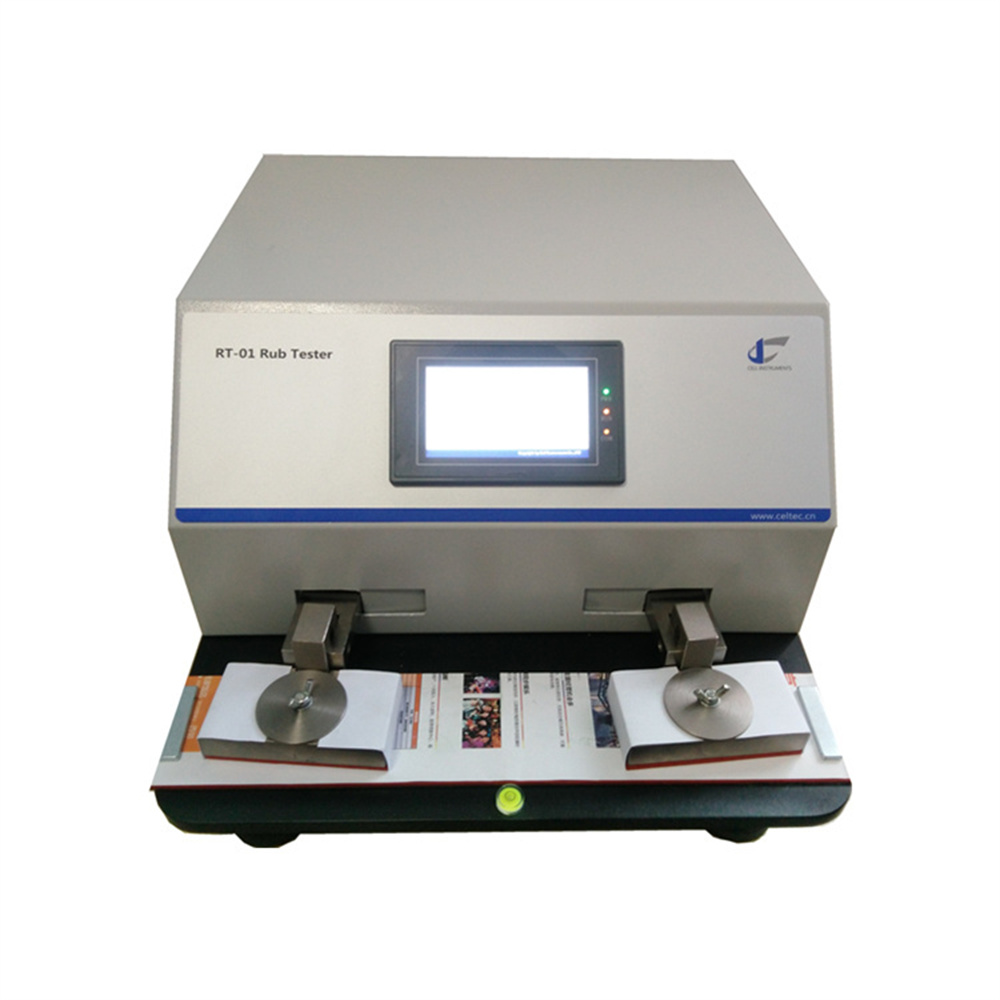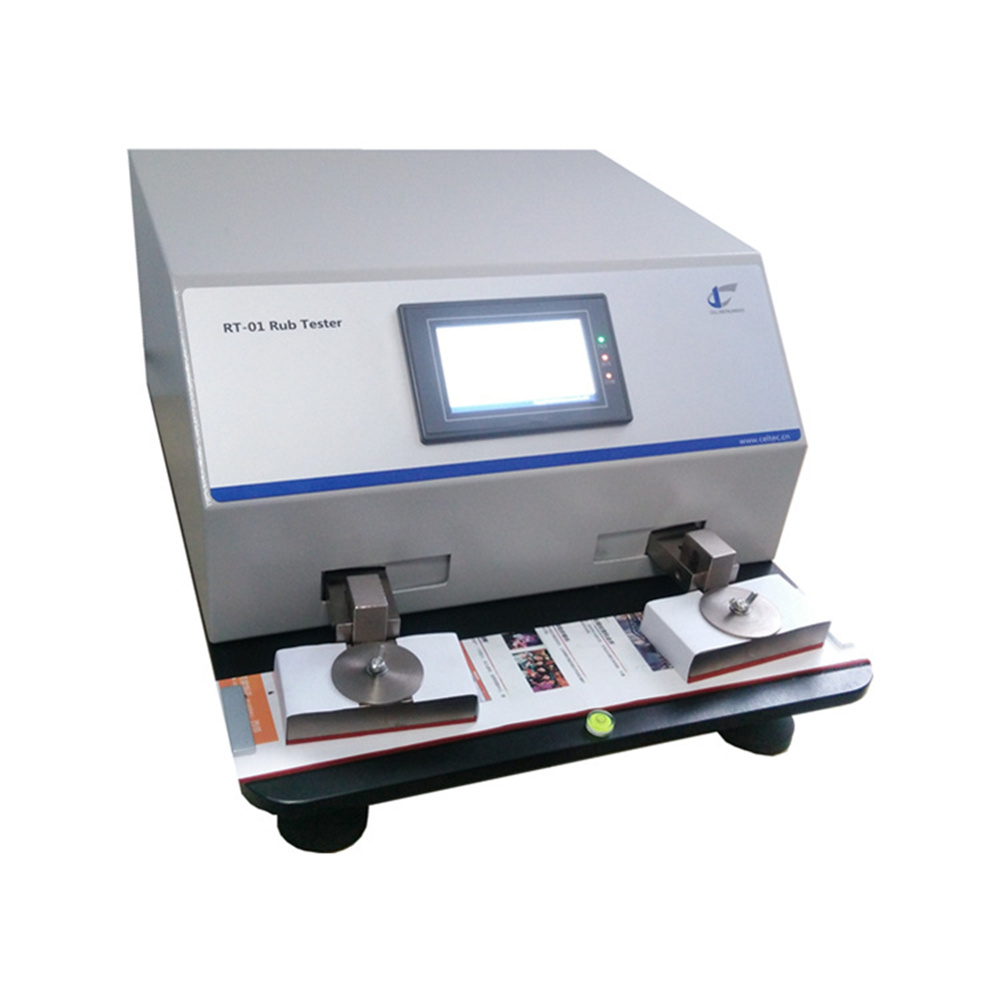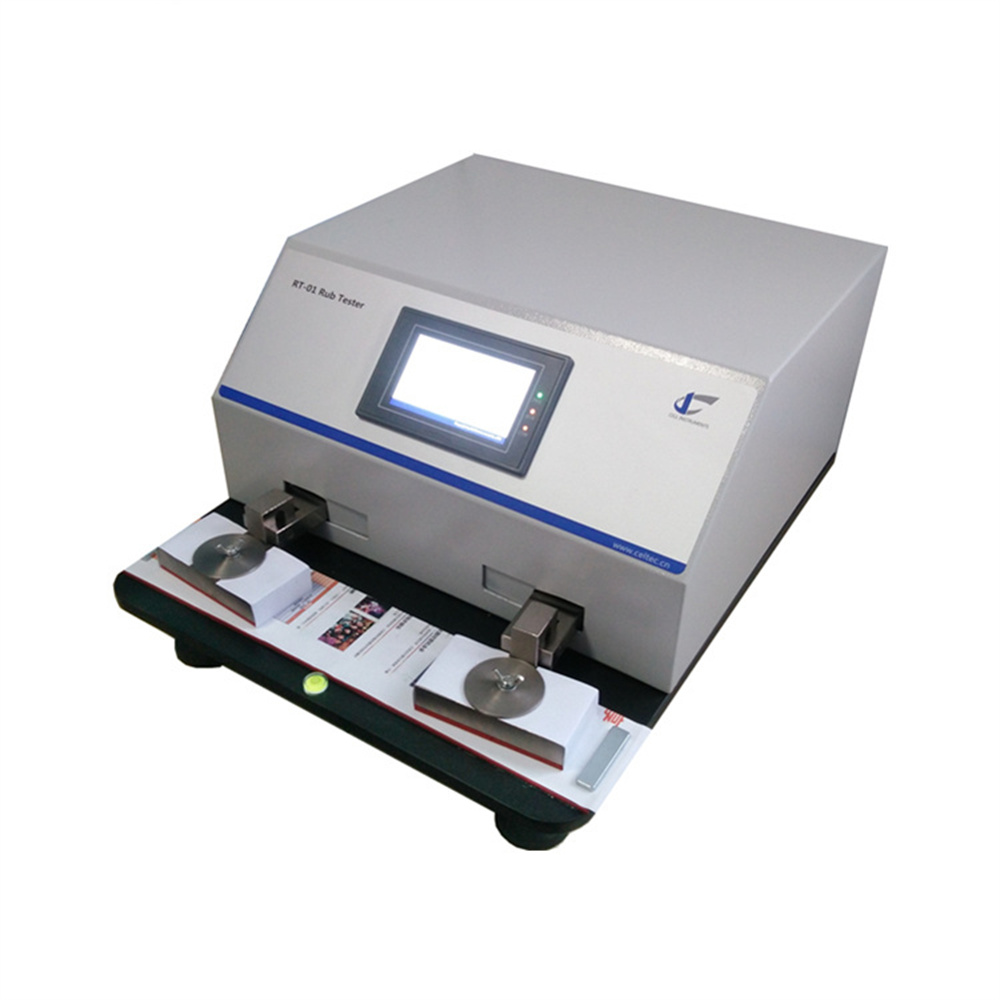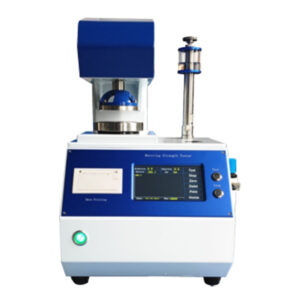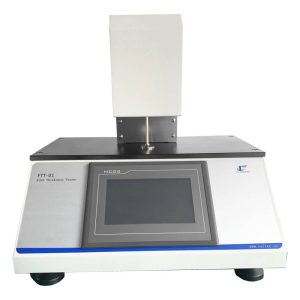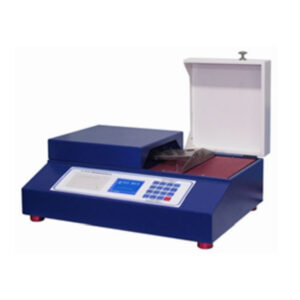の 摩擦試験機 は、インク フィルム、コーティング、その他の材料の摩耗、擦れ、こすれに対する耐性を評価するための必須ツールです。パッケージング、印刷、材料試験に携わる業界向けに設計された Rub Tester は、さまざまな表面のインクとコーティングが摩擦、湿気、熱、その他のストレス条件下でも完全性を維持できるようにします。印刷されたパッケージング材料、ラベル、段ボール、プラスチック フィルムのいずれをテストする場合でも、Rub Tester は、これらの材料が取り扱い、輸送、使用中にどのように機能するかについて正確な情報を提供します。
ラブテスターの紹介
の 摩擦試験機 は、印刷された素材や印刷されていない素材の繰り返しの摩擦や擦り傷をシミュレートするモーター駆動の高精度機器です。このテスト方法は、さまざまな条件下でのインクやコーティングの摩耗や損傷に対する耐性を評価するのに役立ち、品質管理や材料テストに不可欠です。カスタマイズ可能なテスト構成を備えたRub Testerは、 インク性能, 表面強度、 そして 接着 紙、ラベル、包装フィルム、段ボールなど、さまざまな素材に使用できます。
ASTM D5264 とインク摩擦試験機の規格を理解する
ASTM D5264 は、評価するための試験方法を定義した広く認められた標準です。 摩擦抵抗 印刷物、コーティング、インクの耐久性に関する規格です。この規格に準拠することで、業界は自社の製品がさまざまな条件下でのインク性能に必要な耐久性ベンチマークを満たしていることを保証できます。この規格は、摩耗、にじみ、色あせに耐えるインク フィルムを必要とする包装、印刷、材料業界のメーカーにとって非常に重要です。
- ドライラブテストこのテストでは、乾燥条件下でインクが擦り傷や摩耗にどの程度耐えられるかを評価します。取り扱いや輸送中に発生する摩擦をシミュレートします。
- ウェットラブテストこのテストでは、インクが水、油、またはその他の液体と接触する可能性のある実際の状況をシミュレートして、湿気にさらされたときのインクの耐久性を評価します。
- 加熱摩擦試験このテストでは、高温下でのインクとコーティングの性能を検査します。これは、保管中または輸送中に熱にさらされる可能性のあるパッケージに特に関係します。
- ウェットブリードまたは転写このテストでは、湿気にさらされたときにインクが他の表面に移ったりにじんだりするかどうかを評価します。
- ウェットスミアこのテストは、インクが濡れているときの挙動をシミュレートし、圧力がかかったときにインクがどれだけ簡単ににじんだり汚れたりするかを評価します。
- 機能性ラブこのテストは、日常的な取り扱いや使用条件をシミュレートし、インクと表面の長期耐久性を評価します。
を使用することで 摩擦試験機 に準拠する ASTM D5264製造業者は、さまざまな環境および機械的ストレス条件下でのインクとコーティングの性能を正確に評価できます。
摩擦試験の重要性
摩擦試験は、印刷物、コーティング、インクの品質と耐久性を保証する上で重要な役割を果たします。摩擦試験の重要性は、次のような重要な要素を評価できることにあります。
- インク耐性: 摩擦テストにより、インクが摩擦や摩耗にどの程度耐えられるかが明らかになり、メーカーは製品のライフサイクル全体を通じてプロフェッショナルな外観を維持できるようになります。
- 表面強度このテスト方法は、コーティングされた紙、印刷されていない紙、段ボール、またはその他の材料など、基材の強度を評価するのに役立ちます。表面が外部からの力にどの程度耐えられるかを測定します。
- にじみとにじみ: 摩擦テストは、パッケージやラベルの外観と品質に悪影響を及ぼす可能性のある、インクのにじみやにじみなどの潜在的な問題を検出するのに役立ちます。
- 耐熱性加熱摩擦試験では、高温下でのインクやワニスの性能を評価することができ、熱にさらされる包装材料にとって不可欠です。
- 接着: 摩擦テストでは、インクの膜の強さと弱さも区別できるため、メーカーは基材への接着性が低いインクを特定し、印刷物の耐久性を確保することができます。
摩擦試験機の機能とテストの説明
の RT-01 摩擦試験機 は、印刷面または非印刷面の摩擦動作をシミュレートするように設計された、高度なモーター駆動式試験機です。この試験機は、所定のストローク数で試験サンプル上を正確に 57 mm の円弧で移動する重量のある試験片を備えています。これにより、インクやコーティングが摩擦を受ける条件が再現され、実際の使用中に材料がどの程度耐えられるかを予測するのに役立ちます。
試験方法 含む:
- ドライラブ: 乾燥条件下でのインクの耐摩耗性をテストします。
- ウェットラブ: 水分がインクの耐久性に与える影響をシミュレートします。
- 加熱した擦り込み: 高温下でのインクの性能を評価します。
- ウェットブリード/転写: 湿った状態でインクがにじんだり他の表面に転写されるかどうかを評価します。
- ウェットスミア: 湿気にさらされたときのインクの挙動を決定します。
- 機能性ラブ: 通常の取り扱い条件下での長期耐久性をテストします。
摩擦試験機の主な技術的特徴
- PLC制御ユニット: 摩擦試験機には、産業レベルの安定性と信頼性を実現する PLC (プログラマブル ロジック コントローラー) が搭載されており、すべてのテストで一貫した正確な結果が得られます。
- HMIタッチスクリーン操作: ユーザーフレンドリーなヒューマンマシンインターフェース (HMI) タッチスクリーンにより、操作、テスト構成、結果の監視が簡単に行えます。
- 多目的テスト: 摩擦試験機は、乾式摩擦、湿式摩擦、加熱摩擦、機能摩擦など、さまざまなタイプのテストを実行できるため、幅広いテストニーズに適応できます。
- テスト速度調整: 摩擦テストの速度は 1 分あたり 20 ~ 120 ストロークの間で調整でき、さまざまなテスト要件に柔軟に対応できます。
- ダブルテストステーション: デュアル テスト ステーションを備えた Rub Tester は、2 つの試験片を同時にテストできるため、テストの効率が向上します。
- 精密なラビングサークルコントロール: このデバイスは、摩擦円を正確に制御し、正確で再現性のあるテスト結果を保証します。
テストサンプルとアプリケーション
の 摩擦試験機 次のようなさまざまな材料をテストできます。
- インク: 摩耗、汚れ、磨耗に対する耐性を評価します。
- コーティング印刷されたコーティングの耐久性と接着性を評価します。
- プラスチックフィルム: 印刷されたフィルムが摩擦や摩擦にどの程度耐えられるかを判断します。
- 紙: 包装やラベルに使用されるコート紙および非コート紙を含みます。
- 包装資材: 取り扱い中や輸送中に摩擦により接触する可能性のある段ボール、カートン、その他の梱包材。
- ラベル: 摩耗にさらされた印刷ラベルの品質と耐久性を確認します。
摩擦テストの恩恵を受ける業界には、次のようなものがあります。
- パッケージ: 印刷された梱包材の外観と機能性が維持されるようにします。
- 食品および飲料: 湿気や熱にさらされた印刷ラベルや包装の耐久性を検証します。
- 医療および医薬品: 医療用パッケージの印刷物の完全性を確保します。
- 繊維およびプラスチック: プリントされた繊維製品とプラスチックフィルムの長期耐久性をテストします。
標準とコンプライアンス
の 摩擦試験機 いくつかの重要な業界標準に準拠しています。
- ASTM D5264この規格は、印刷物およびコーティングの耐摩擦性の試験方法を規定しています。
- その他の関連規格: ラブテスターは次のような基準にも準拠しています。 タッピT830, ASTM F1571, フィナット FTM 27、 そして JIS K 5701グローバルな互換性と正確性を保証します。
主な技術的パラメータ
| 重量 | 908g (2ポンド) /8.9N;1816g (4ポンド) /17.8N |
| スピード | 20~120 cpmのフリー設定 |
| 標本数 | 1~2 |
| 回転半径 | 185ミリメートル |
| 弧の長さ | 57mm±1mm |
| 寸法 | 390x480x220 mm(長さx幅x高さ) |
| 力 | 110〜220V 50/60Hz |
の RT-01 摩擦試験機 さまざまな条件下での印刷物やコーティングの耐久性を評価するための高度な機能と正確な制御を提供します。多彩なテスト オプション、簡単な操作、ASTM D5264 などの主要な規格への準拠を備えた Rub Tester は、インクやコーティングの堅牢な品質管理を必要とする業界にとって欠かせないツールです。パッケージ、ラベル、印刷物の耐久性と見た目の美しさを保証するのに役立つため、幅広い業界のメーカーにとって不可欠な投資となります。
よくある質問
- Q1: ASTM D5264 規格は何に使用されますか?
- ASTM D5264 は、印刷物やコーティングの耐摩擦性をテストし、取り扱い、輸送、使用中の耐久性を保証するために使用されます。
- Q2: Rub Tester はどのようにしてインク耐性を測定するのですか?
- 摩擦試験機は、インクフィルム上での繰り返し摩擦動作をシミュレートし、乾燥、湿潤、加熱条件下での擦り傷、汚れ、色あせに対する耐性を測定します。
- Q3: 摩擦試験機でどのような種類の表面を試験できますか?
- 摩擦試験機は、紙、プラスチックフィルム、ラベル、包装材、段ボールなど、さまざまな表面をテストできます。
- Q4: 摩擦試験機は乾式摩擦試験と湿式摩擦試験の両方を実行できますか?
- はい、Rub Tester は、乾式、湿式、加熱式、機能的摩擦テストを実行できるため、さまざまなテスト ニーズに適応できます。
- Q5: RT-01 摩擦試験機はどのようにして一貫した結果を保証しますか?
- RT-01 摩擦試験機は、PLC 制御システム、精密な摩擦円制御、調整可能な試験速度を備えており、正確で再現性のある試験結果を保証します。

